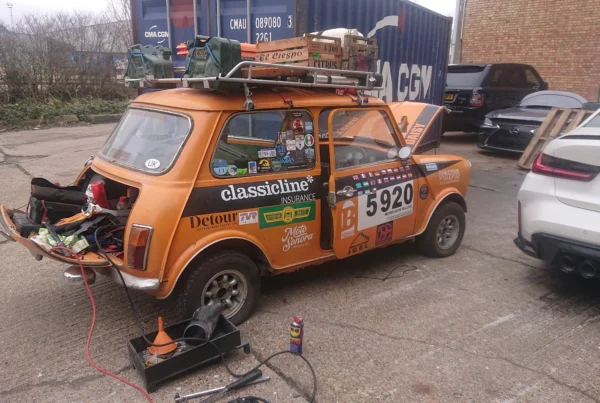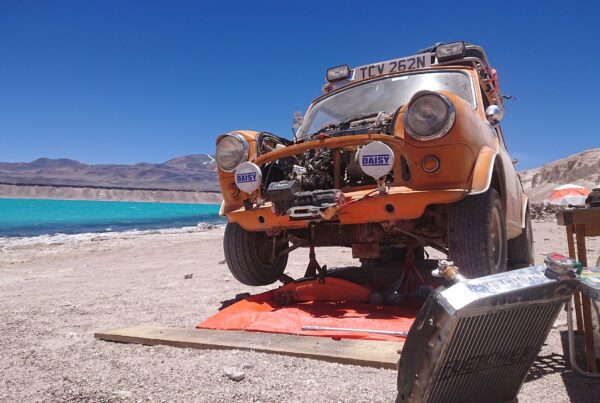As road trips go, driving up the world’s highest volcano is a pretty unusual one, and as you’d expect, experiencing it from being behind the wheel wasn’t exactly run-of-the-mill either, as ClassicLine’s resident road tripper, Ben Coombs explains…
From a driving perspective, the ClassicLine Insurance sponsored Mini6000 Expedition was very much a trip of two halves. Firstly, there was the 4,000-odd miles covered getting to and from our objective – the Ojos del Salado volcano, deep in Chile’s Atacama Desert. And then there was the 24 days we spent on the mountain itself, coaxing the Mini upwards. The 4,000 miles were much as you’d expect driving a Mini across South America would be – rather uncomfortable, fairly bouncy, and pretty slow. Because of the gearbox’s short final drive, any speeds of much over 50 mph felt like an abuse of high-revving machinery, and so progress was made slowly, on the long, straight and often uninteresting roads of central Argentina, and Chile. But these long days were just a means to an end, as the prospect of driving up the world’s highest volcano was what had brought us to South America in the first place. And to do that, first of all we had to get to its base.
Things started gently enough, with reasonably smooth gravel tracks taking us into the Atacama, and not really challenging the Mini until the thin air started to affect its drivability. This began once we passed around 3,500 metres altitude, and initially manifested itself as a reluctance to pull away. When bringing up the clutch, the engine would almost instantly lose power as the mixture in the carburettor became suddenly lean, necessitating the clutch to be depressed and the engine revved up for a second time. Or at higher altitudes, even a third time. Using this method, it was possible to get the car moving, and once it was rolling along and the clutch was up, it would drive normally, with the supercharger helping to provide power in the thin air. However, this lean cutting was an issue which stayed with us at all times on the mountain, and made the driving most challenging.
In spite of this, however, once the car was up and running, it would scamper along the dirt tracks of the high Atacama in a fine manner. The raised suspension proved just high enough to avoid most of the obstacles, while the well-protected underside proved a match for those boulders which did hit. The only surface which flummoxed the car was soft sand, as its combination of two wheel drive and small wheels proved unequal to the challenge, even when tyre pressures were lowered.
This left us with a few options – when soft sand blocked the Mini’s path, we could either manhandle the car across via pushing, and using planks of wood as sand ladders, or we could tow it with the Range Rover. Generally, the latter option was preferred, being both quicker, and requiring less effort.
The Range Rover’s towing skills were also needed as both the altitude, and the slope angle, increased. The lean cut issue meant that once we were over 5,000 metres, it was sometimes impossible for the Mini to perform a simple hill start. In these situations, if rolling down to some flat ground and getting some speed up wasn’t an option, then the Range Rover would once again be called on to tow the Mini until the slope lessened. These issues made getting the two cars ever higher on the volcano very much a team effort.
And this became more and more true as we pushed higher. The deep, sandy slopes became more common, and were sometimes so challenging that the Range Rover was unable to tow the Mini, necessitating us to use its winch to make progress, sometimes with the Range Rover as an anchor point, on other occasions using boulders. Due to the handicap we’d given ourselves by insisting on using a two wheel drive Mini on the mountain, every metre of altitude it gained was a challenge, and towards its highpoint, where simply starting the car was often a 10 minute challenge, and pulling away on any kind of slope was impossible, the realms of impossibility began to impede on our adventure. The adventure which had began as a 1,500 mile drive across South America to get to the mountain, had now reached a stage where driving further was impossible. In the final effort to get to the Mini’s highpoint, the gearbox remained in neutral, with all forward progress being provided by the Mini’s winch. And so, fifteen metres at a time, Daisy the Mini dragged herself upwards, until a combination of angle and altitude caused her engine to cut out, and forward progress was no longer an option.
And then, there came the time to descend. And with gravity on its side the Mini showed us what might have been were its traction and carburettor issues solved. Down barely touched mountainside, and rough 4×4 tracks, for mile after mile, the Mini simply flew. Its ground clearance was just enough, and its narrow width enabled it more options when squeezing past boulders, than a normal, chunky 4×4. It was a good car, a good off-roader, even. It was just too far out of its comfort zone when faced with the slopes of the world’s highest volcano.
From a driving perspective, it was certainly a trip of two halves, with the Mini’s fine on-road performance being offset by the often frustrating difficulties it encountered high on the mountain. With a few tweaks to its fuelling, and possibly some more aggressive tyres, it may well have performed much better up there. But then, the whole point of Mini6000 was to see what could be achieved with the world’s most iconic car, on the world’s highest volcano. It was supposed to be a challenge, and from a driving perspective, it certainly turned out to be just that. Especially where the driving experience was concerned.













